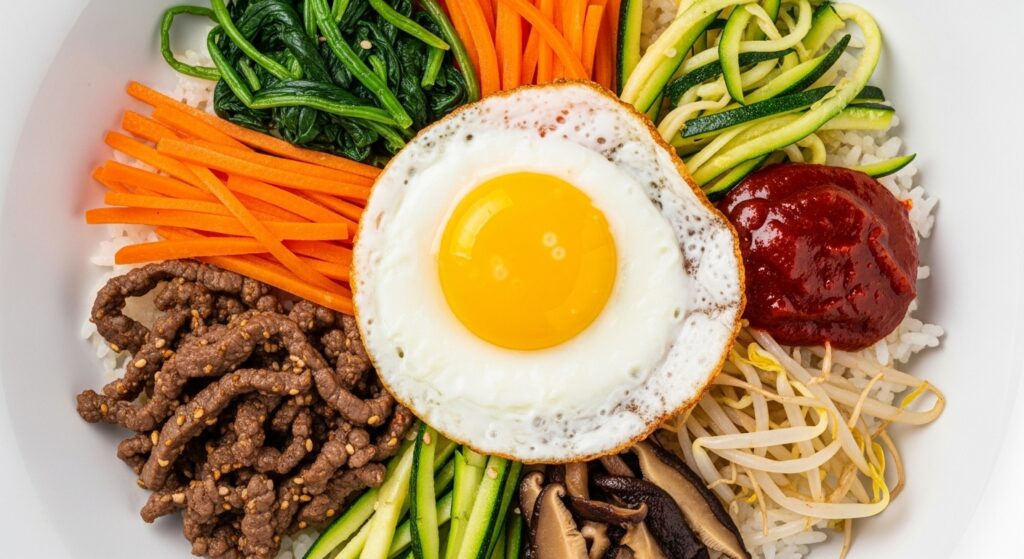A Rainbow in a Bowl
When foreigners first encounter bibimbap, the reaction is almost always the same: surprise at its beauty. Unlike many rice dishes that hide ingredients beneath sauces, bibimbap presents them proudly on top — a rainbow of vegetables, a sunny egg, slices of beef or tofu, and a vibrant dollop of red gochujang. It looks less like a meal and more like a painter’s palette.
Many visitors to Korea hesitate before digging in. “Do I really have to mix this beautiful bowl?” The answer is yes. And in that moment of mixing, bibimbap transforms from a colorful arrangement into a flavorful harmony.
The Language of Colors

Korean culture has long valued the balance of colors in food. Traditionally, the “five colors” — red, green, yellow, white, and black — represent harmony in nature and health. Red may symbolize passion and protection, green vitality, yellow balance, white purity, and black wisdom.
Bibimbap embodies this philosophy. Each topping not only contributes taste but also represents a color that balances the whole. For foreigners, this is more than just food — it’s a cultural lesson about harmony, balance, and the Korean belief that meals nourish both body and spirit.
Mixing as Philosophy

To many foreigners, the act of mixing everything together feels unusual. In Western dining, presentation often stays intact until the last bite. But in Korea, bibimbap is not meant to remain beautiful for long. Stirring it all together — rice, vegetables, beef, egg, and chili paste — is the essential step.
This mixing is symbolic. It reflects unity: many different elements becoming one. It is a delicious metaphor for life in Korea, where individuality and community exist side by side, blending to create something greater than the sum of its parts.
Bibimbap Across the Globe

What makes bibimbap fascinating for foreigners is its adaptability. In Jeonju, the “birthplace of bibimbap,” the bowl is rich with seasoned vegetables and beef. In Jinju, raw beef creates a lighter version. In Tongyeong, seafood adds coastal flair. Abroad, chefs experiment with quinoa, avocado, or vegan protein, making bibimbap a truly global dish.
Travelers often enjoy discovering these variations, realizing that while the toppings may change, the heart of bibimbap — color, balance, and mixing — remains the same.
A Healthy Rainbow
Beyond philosophy and tradition, bibimbap is also admired for its nutrition. Each topping offers unique health benefits: spinach for iron, carrots for beta-carotene, mushrooms for fiber, and eggs or beef for protein. Combined, the dish delivers a balanced meal that fits perfectly into modern healthy-eating trends.
For foreigners, bibimbap feels both indulgent and healthy. It is hearty enough to satisfy, yet colorful and light enough to feel nourishing. This makes it one of the easiest Korean dishes to introduce to newcomers who may be hesitant about spicier or stronger flavors.
To complete your meal, try pairing bibimbap with Sigeumchi-namul (Korean Seasoned Spinach). Its light sesame aroma and tender greens make the perfect side to this colorful bowl.
Experience It Yourself

The best way to understand bibimbap is to eat it in Korea. Served in a hot stone bowl (dolsot), the rice forms a crispy crust while the vegetables and gochujang blend into a comforting, flavorful mix. For many visitors, that first sizzling spoonful is a highlight of their trip.
And if you cannot travel right now, you can still try it at home. All you need is rice, assorted vegetables, and a bit of gochujang. 👉 Scroll down to the recipe card below for a step-by-step guide to making bibimbap yourself.
“If you enjoy comforting Korean rice dishes like Bibimbap, you might also love my Kimchi Fried Rice recipe — another simple, satisfying way to bring warmth to your table.“
Conclusion
Bibimbap is more than just a rice bowl. It is a work of art, a cultural philosophy, and a symbol of harmony in everyday life. For foreigners, it offers a unique way to taste Korea’s values through food — colorful, balanced, and deeply satisfying.
Whether you enjoy it in a traditional Korean restaurant, on the streets of Jeonju, or in your own kitchen, bibimbap proves that food can be art, nourishment, and culture all in one bowl.

Korean Bibimbap (Mixed Rice with Vegetables)
Equipment
- 1 Large bowl For serving bibimbap
- 1 Frying pan For stir-frying vegetables and beef
- 1 Small pot For blanching spinach and bean sprouts
Ingredients
- 2 bowls Cooked rice Warm and freshly cooked
- 150 g Beef (ground or thinly sliced) Seasoned with soy sauce, garlic, sugar
- 1 handful Spinach Blanched
- ½ Carrot Julienned, stir-fried lightly
- ½ Zucchini Julienned, stir-fried lightly
- 1 handful Bean sprouts Blanched with a pinch of salt
- 3-4 Shiitake mushrooms Sliced, stir-fried
- 2 Eggs Fried sunny side up
- 2 tsp Sesame oil Drizzle before serving
- 1 tsp Sesame seeds For garnish
- 2 tbsp Gochujang (Korean chili paste) Served on the side
- Garlic, soy sauce, sugar, salt, pepper For seasoning beef and vegetables
Instructions
- Prepare warm cooked rice.
- Blanch spinach and bean sprouts with a pinch of salt, then drain.
- Stir-fry carrot, zucchini, and shiitake mushrooms separately with a little oil.
- Season beef with soy sauce, garlic, sugar, sesame oil, and stir-fry until cooked.
- Fry eggs sunny side up.
- Place rice in a large bowl.
- Arrange vegetables and beef neatly on top of the rice.
- Add the fried egg in the center.
- Drizzle sesame oil, sprinkle sesame seeds, and serve with gochujang.
- Mix everything well before eating.
Notes
For a vegetarian option, replace beef with mushrooms or tofu.
For a vegan option, skip the egg and add extra vegetables.


